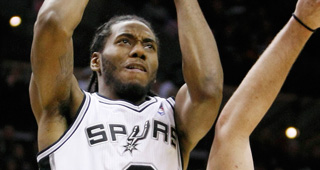While Kevin Durant has been tearing through this season with his MVP play, the San Antonio Spurs have quietly been building steam and momentum as they typically do in the playoffs heading into the Western Conference Finals against the Oklahoma City Thunder.
Kawhi Leonard (6’7”) gives the Spurs the best opportunity to shut down Durant (6’11”) tightly throughout the series. Leonard counters Durant with a 7’3” wingspan compared with Durant’s 7’4” wingspan.
The previous time Leonard and Durant met in the playoffs, Durant carved up him and the Spurs, shooting at a 56 percent clip and 41.2 percent from three. Back in the 2012 Western Conference Finals, Leonard was still learning things on the fly as a rookie, playing meaningful minutes against Durant. Since that encounter, Leonard has matched up again LeBron James in The Finals, and is obviously a much more reliable and experienced player than he was then.
Leonard leads the Spurs' defensive intensity when he is on the court. With Leonard on the court, the team allowed 99.7 points per 100 possessions in the regular season, along with allowing 101.2 points in the playoffs. When Leonard is off the court, the Spurs allow 105.1 and 111.9 points respectively for the regular season and playoffs.
Throughout the regular season, one in which the Thunder swept the season series against the Spurs 4-0, Scott Brooks uses Durant in multiple ways to score effectively. Brooks allows Durant to score off variations of the pick and roll, shooting off multiple screens, post-game, and isolation, where Durant always has an advantage.
Leonard must force Durant into becoming a scorer rather than a playmaker. While Leonard was on the court against Durant during the regular season, he managed to hold him to nine assists and 15 turnovers along with shooting slightly under 47 percent and 1-8 from three in 48 minutes.
Keeping Durant as uncomfortable as possible, Leonard must be committed to forcing him into shooting off balance as much as possible to limit his superb shooting efficiency. Leonard needs to continue to swarm Durant on the perimeter and give him as little breathing space as possible as a means to make scoring more challenging for him.
One thing the Thunder do well is creating separation for Durant through numerous off-ball screens that open up time and space for him to score. Durant’s ability to run off screens along with his quick shooting release always create havoc for opposing teams to deal with. Known as one of the best at avoiding screens, Leonard will have his hands full chasing Durant off screens.
The one telling stat that will distinguish if Durant performs at a high level from a game-by-game basis is the number of free throw he attempts. Having led the league in free throw attempts at 9.9 during the regular season, Durant must continue to get to the charity stripe if the Thunder are going to have any realistic shot at reaching The Finals. When Durant attempts at least 10 free throws during these playoffs, the Thunder are 4-2 in those games.
With Serge Ibaka out for the remainder of the playoffs, the margin for error simply got smaller for Durant and Russell Westbrook. Ibaka was Durant’s security blanket on the weak side whenever he was doubled or triple teamed. Oklahoma City will need Durant to perform at the MVP level he has been all season to make up for the loss of production from Ibaka.
Leonard and the Spurs understand that nobody will be able to prevent Durant from getting his shots, but they must try and limit his production as much as possible. If the Spurs want to be a Finals participant for the second straight year, Leonard must slow down Durant.


